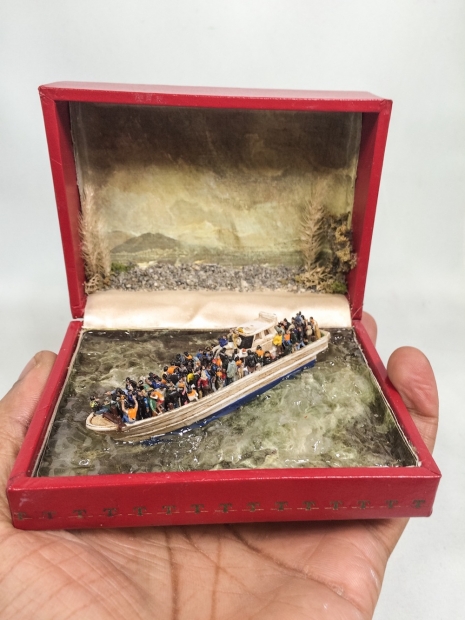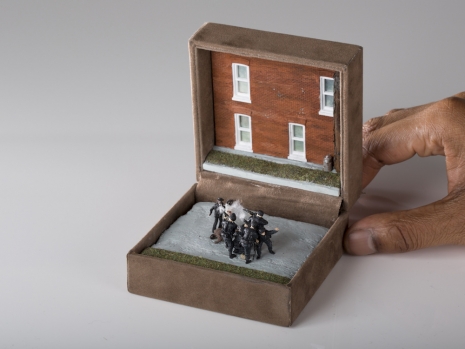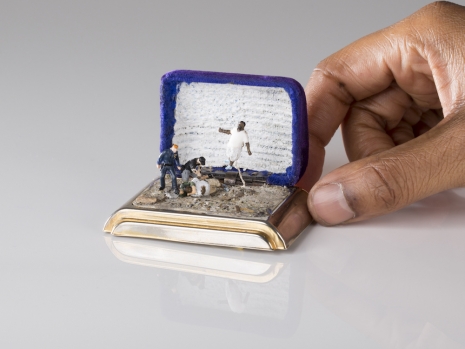
‘Deluge’ (2015).
Maybe it was the miniature world of The Sims or the illustrations in Where’s Waldo? with its crammed panoramic scenes filled with chaos and action that first suggested the possibility to Canadian artist Curtis “Talwst” Santiago of producing tiny dioramas inside jewelry boxes. Or, maybe it was the Parisian dude living in Vancouver, from whom Talwst bought old magazines and posters to make his collages, who one day tossed him an engagement ring box and said, “I want to see what you can do with this.”
It didn’t take long. Talwst’s turned the box into a diorama of a beach scene with his girlfriend coming out of the water like Botticelli’s Venus. It was the start of a process with which Talwst creates astonishing works of power and beauty.
Talwst—pronounced “Tall Waist” a reference to his Caribbean grandfather’s and his father’s nickname—was born and raised in Sherwood Park, Alberta, Canada. His father emigrated from Trinidad to Fort McMurray in 1969. The experience of growing up in Canada was different to the life Talwst discovered when he moved to New York. As a Black man then living in Brooklyn, he found himself stopped and frisked by cops for no other reason than the color of his skin.
When I came to the States, there was some difference between me and the young man here that I see. But the minute I put on that big black hoodie, my black sweatpants, and I’m standing outside having a smoke outside of my studio, I’m immediately viewed as ‘nobody,’ and they know nothing about me. I realized that could happen to anyone, at any time. How many young men, that are loved by their families and are good people, were being killed? That resonated with me. It was the start of looking at Black identity in America because it’s significantly different than Canada.
The state-sanctioned racism and violence against the Black community made Talwst understand that Black lives have less value in America, and that at any moment his own “life could be taken or seen as having no value.”
Watching news reports of Black men being murdered on the streets for no reason led Talwst to produce dioramas on the shooting by police of Michael Brown in Ferguson, Missouri, in 2014, and the strangulation by police of Eric Garner on Staten Island in 2014.
[W]ith Michael Brown, it’s almost like a Goya painting [The Third of May]. Where we have images of this person beforehand and then we have images of him dead.
It’s a plethora of feelings. It’s frustration, it’s feeling thankful that I’m standing in a position where I’m able to observe and look at it, and not feel lost, locked in it, trapped by it. With the Eric Garner tape, you watch the whole thing happen in front of you. Working on that piece was so sad for me. I felt so much sorrow for his family. You hear him beg for his life.
Just before Garner’s murder, Talwst had seen Goya’s Disasters of War etching Por Qué? of “this guy being choked against a tree by three soldiers.”
A few days later, it’s 4 AM in the morning and I’m watching the YouTube video [of Garner being choked by police officers], and it draws to mind the etchings. I started crying, working and crying and feeling so sad and hurt. But I learned so much from that. I learned that I had the ability to channel my emotions into the work, if it’s honest work. But I held in the back of mind, this is not a monument to death. This is the spark to thinking and looking differently for a lot of people that are going to view this and see the video. It had to be a catalyst, mainly for his family. They’ve seen the moment of his death so much, but they never saw a moment of his ascension, his soul moving. And that’s what I wanted to create.
Talwst has also produced dioramas on the plight of Syrian refugees (Deluge) and the rape of indigenous people (The Rape). He also has produced work on environmentalism, gender and identity. His dioramas have been featured in art galleries and museums across America and Canada, and in Paris, Johannesburg, South Africa, and Geneva, Switzerland. And you can see more of Curtis Talwst Santiago’s work here. Click images to see larger picture.

‘Execution of Unarmed Black Men’ aka ’ Execution of Michael Brown’ (2014).

‘Por qué?’ (2014).
More of Talwst’s astonishing dioramas, after the jump…






